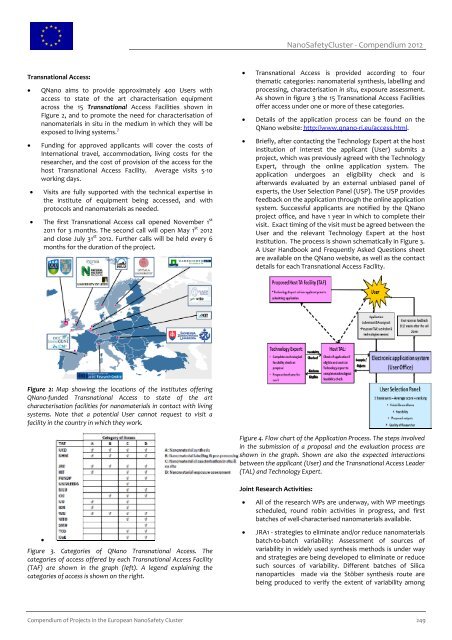Timing, hosts and locations of (grouped) events of NanoImpactNet
Timing, hosts and locations of (grouped) events of NanoImpactNet
Timing, hosts and locations of (grouped) events of NanoImpactNet
You also want an ePaper? Increase the reach of your titles
YUMPU automatically turns print PDFs into web optimized ePapers that Google loves.
Transnational Access:<br />
� QNano aims to provide approximately 400 Users with<br />
access to state <strong>of</strong> the art characterisation equipment<br />
across the 15 Transnational Access Facilities shown in<br />
Figure 2, <strong>and</strong> to promote the need for characterisation <strong>of</strong><br />
nanomaterials in situ in the medium in which they will be<br />
exposed to living systems. 7<br />
� Funding for approved applicants will cover the costs <strong>of</strong><br />
International travel, accommodation, living costs for the<br />
researcher, <strong>and</strong> the cost <strong>of</strong> provision <strong>of</strong> the access for the<br />
host Transnational Access Facility. Average visits 5‐10<br />
working days.<br />
� Visits are fully supported with the technical expertise in<br />
the institute <strong>of</strong> equipment being accessed, <strong>and</strong> with<br />
protocols <strong>and</strong> nanomaterials as needed.<br />
� The first Transnational Access call opened November 1 st<br />
2011 for 3 months. The second call will open May 1 st 2012<br />
<strong>and</strong> close July 31 st 2012. Further calls will be held every 6<br />
months for the duration <strong>of</strong> the project.<br />
Figure 2: Map showing the <strong>locations</strong> <strong>of</strong> the institutes <strong>of</strong>fering<br />
QNano‐funded Transnational Access to state <strong>of</strong> the art<br />
characterisation facilities for nanomaterials in contact with living<br />
systems. Note that a potential User cannot request to visit a<br />
facility in the country in which they work.<br />
�<br />
Figure 3. Categories <strong>of</strong> QNano Transnational Access. The<br />
categories <strong>of</strong> access <strong>of</strong>fered by each Transnational Access Facility<br />
(TAF) are shown in the graph (left). A legend explaining the<br />
categories <strong>of</strong> access is shown on the right.<br />
NanoSafetyCluster ‐ Compendium 2012<br />
� Transnational Access is provided according to four<br />
thematic categories: nanomaterial synthesis, labelling <strong>and</strong><br />
processing, characterisation in situ, exposure assessment.<br />
As shown in figure 3 the 15 Transnational Access Facilities<br />
<strong>of</strong>fer access under one or more <strong>of</strong> these categories.<br />
� Details <strong>of</strong> the application process can be found on the<br />
QNano website: http://www.qnano‐ri.eu/access.html.<br />
� Briefly, after contacting the Technology Expert at the host<br />
institution <strong>of</strong> interest the applicant (User) submits a<br />
project, which was previously agreed with the Technology<br />
Expert, through the online application system. The<br />
application undergoes an eligibility check <strong>and</strong> is<br />
afterwards evaluated by an external unbiased panel <strong>of</strong><br />
experts, the User Selection Panel (USP). The USP provides<br />
feedback on the application through the online application<br />
system. Successful applicants are notified by the QNano<br />
project <strong>of</strong>fice, <strong>and</strong> have 1 year in which to complete their<br />
visit. Exact timing <strong>of</strong> the visit must be agreed between the<br />
User <strong>and</strong> the relevant Technology Expert at the host<br />
institution. The process is shown schematically in Figure 3.<br />
A User H<strong>and</strong>book <strong>and</strong> Frequently Asked Questions sheet<br />
are available on the QNano website, as well as the contact<br />
details for each Transnational Access Facility.<br />
Figure 4. Flow chart <strong>of</strong> the Application Process. The steps involved<br />
in the submission <strong>of</strong> a proposal <strong>and</strong> the evaluation process are<br />
shown in the graph. Shown are also the expected interactions<br />
between the applicant (User) <strong>and</strong> the Transnational Access Leader<br />
(TAL) <strong>and</strong> Technology Expert.<br />
Joint Research Activities:<br />
� All <strong>of</strong> the research WPs are underway, with WP meetings<br />
scheduled, round robin activities in progress, <strong>and</strong> first<br />
batches <strong>of</strong> well‐characterised nanomaterials available.<br />
� JRA1 ‐ strategies to eliminate <strong>and</strong>/or reduce nanomaterials<br />
batch‐to‐batch variability: Assessment <strong>of</strong> sources <strong>of</strong><br />
variability in widely used synthesis methods is under way<br />
<strong>and</strong> strategies are being developed to eliminate or reduce<br />
such sources <strong>of</strong> variability. Different batches <strong>of</strong> Silica<br />
nanoparticles made via the Stöber synthesis route are<br />
being produced to verify the extent <strong>of</strong> variability among<br />
Compendium <strong>of</strong> Projects in the European NanoSafety Cluster 249






